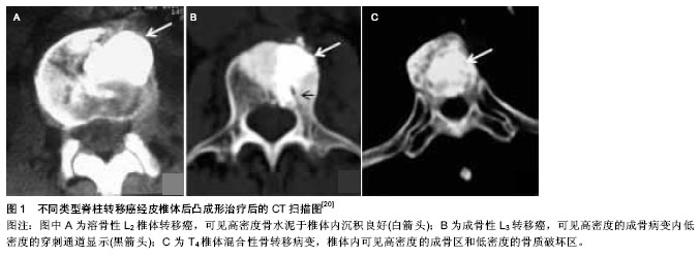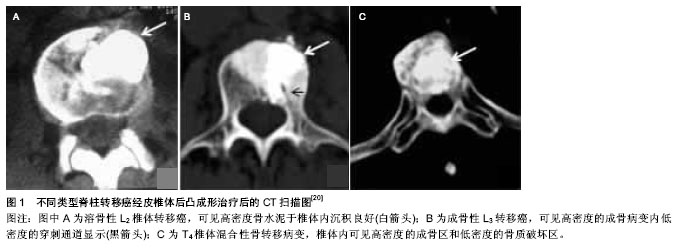Chinese Journal of Tissue Engineering Research ›› 2015, Vol. 19 ›› Issue (16): 2613-2618.doi: 10.3969/j.issn.2095-4344.2015.16.029
Previous Articles Next Articles
Minimally invasive treatments of spinal metastases: vertebroplasty, radiofrequency ablation and radiation therapy
Guan Kai, Liu Chuan, Li Fang
- Department of Spinal Surgery, General Hospital of Beijing Military Region, Military Institute of Traumatic Orthopedics, Beijing 100700, China
-
Received:2015-02-06Online:2015-04-16Published:2015-04-16 -
About author:Guan Kai, Master, Associate chief physician, Department of Spinal Surgery, General Hospital of Beijing Military Region, Military Institute of Traumatic Orthopedics, Beijing 100700, China
CLC Number:
Cite this article
Guan Kai, Liu Chuan, Li Fang. Minimally invasive treatments of spinal metastases: vertebroplasty, radiofrequency ablation and radiation therapy[J]. Chinese Journal of Tissue Engineering Research, 2015, 19(16): 2613-2618.
share this article

2.1 椎体骨水泥增强 椎体骨水泥增强包括椎体成形及椎体后凸成形治疗。 2.1.1 安全性和止痛效果 因脊柱转移瘤位置变化大,很多对椎体后壁有侵及甚至对硬膜囊有轻度压迫,所以对脊柱转移瘤患者行骨水泥增强较对骨质疏松压缩骨折患者风险更高。Calmels等[11]报告脊柱转移瘤患者行骨水泥增强严重并发症发生率为0-11.5%(平均2%),死亡率为0-7%。注入骨水泥4 mL以上发生并发症概率明显增高,虽然这一数字文献支持有限,但骨水泥注入量与并发症是明显相关的[12]。 Hadjipavlou等[13]经过对既往文献总结并进行统计分析表明,椎体成形对椎体肿瘤的疼痛缓解率为75.9%-92.5%;椎体后凸成形对椎体肿瘤的疼痛缓解率为75.6%-98.2%,两者之间比较差异无显著性意义。癌症骨折研究小组(Cancer Fracture Evaluation,CAFÉ)发表1篇多中心前瞻性随机对照的高等级文献,将分布在欧洲、美国、加拿大和澳大利亚的22个中心的134例脊柱转移瘤疼痛患者随机分到椎体后凸成形组(n=70)和非手术组(n=64),最小年龄22岁,肿瘤侵及1-3个节段,随访结果显示椎体后凸成形可明显快速有效减轻疼痛,减少致残率,提高患者生活质量,减少止痛药的用量[14]。 骨水泥增强的止痛机制有化学毒性作用、热坏死效应及固化对骨折椎体的力学稳定作用,现阶段的研究认为椎体成形维持椎体力学的稳定性是椎体成形缓解疼痛的主要机制。Nakano等[15]将无毒性磷酸钙作为骨水泥对患者行椎体成形,实验组和对照组相比也能很好地缓解患者的疼痛症状,所以作者认为骨水泥的化学毒性不是缓解患者疼痛的主要因素。Deramon等[16]研究发现甲基丙烯酰甲酯骨水泥在聚合过程中能够产生热量,但椎管内的温度低于41 ℃,所以他们认为疼痛的缓解不可能为椎体神经末梢热坏死所致。Verlaan等[17]对羊腰椎行椎体成形的研究发现,在骨水泥与骨组织相邻界面平均最高温度为44.6 ℃,这样的温度不足以导致局部组织坏死。Anselmetti等[18] 则首次对腰椎骨质疏松性骨折患者进行研究,发现11种不同的骨水泥单体在聚合过程中释放的热量均不能使温度维持45 ℃以上超过 30 min,所以作者认为骨水泥的聚合放热不会导致感觉神经的损伤。综上所述,这些研究结果表明骨水泥单体"

| [1] Jemal A,Siegel R,Ward E,et al.Cancer statistics,2007.CA Cancer J Clin 2007;57(1):43-66. [2] Manabe J,Kawaguchi N,Matsumoto S,et al.Surgical treatment of bone metastasis: indications and outcomes.Int J Clin Oncol. 2005;10:103-111. [3] Witham TF,Khavkin YA,Gallia GL,et al.Surgery insight: current management of epidural spinal cord compression from metastatic spine disease. Nat Clin Pract Neurol. 2006;2: 87-94; quiz 116. [4] Bartels RH, van der Linden YM, van der Graaf WT.Spinal extradural metastasis: review of current treatment options.CA Cancer J Clin.2008;58:245-259. [5] Pavlakis N,Schmidt R,Stockler M.Bisphosphonates for breast cancer.Cochrane Database Syst Rev.2005;20(3): CD003474. [6] Yuen KK,Shelley M,Sze WM,et al.Bisphosphonates for advanced prostate cancer. Cochrane Database Syst Rev. 2006; 4:CD006250. [7] Mercadante S.Malignant bone pain: pathophysiology and treatment. Pain.1997;69: 1-18. [8] Saad F,Lipton A,Cook R,et al.Pathologic fractures correlate with reduced survival in patients with malignant bone disease. Cancer.2007;110:1860-1867. [9] Ecker RD, Endo T, Wetjen NM,et al.Diagnosis and treatment of vertebral column metastases.Mayo Clin Proc.2005;80: 1177-1186. [10] Gasser T,Sandalcioglu IE,El Hamalawi B,et al.Surgical treatment of intramedullary spinal cord metastases of systemic cancer: functional outcome and prognosis. J Neurooncol.2005;73:163-168. [11] Calmels V,Vallee JN,Rose M,et al.Osteoblastic and mixed spinal metastases: evaluation of the analgesic efficacy of percutaneous vertebroplasty.AJNR Am J Neuroradiol.2007;28: 570-574. [12] Tseng YY,Lo YL,Chen LH,et al.Percutaneous polymethylmethacrylate vertebroplasty in the treatment of pain induced by metastatic spine tumor.Surg Neurol.2008;70 Suppl 1: S1:78-83; discussion S71:83-74. [13] Hadjipavlou AG,Tzermiadianos MN, Katonis PG,et al. Percutaneous vertebroplasty and balloon kyphoplasty for the treatment of osteoporotic vertebral compression fractures and osteolytic tumours. J Bone Joint Surg Br.2005;87: 1595-1604. [14] Berenson J,Pflugmacher R,Jarzem P,et al.Balloon kyphoplasty versus non-surgical fracture management for treatment of painful vertebral body compression fractures in patients with cancer: a multicentre, randomised controlled trial. Lancet Oncol.2011;12:225-235. [15] Nakano M,Hirano N,Ishihara H,et al.Calcium phosphate cement-based vertebroplasty compared with conservative treatment for osteoporotic compression fractures: a matched case-control study. J Neurosurg Spine.2006;4: 110-117. [16] Deramond H, Wright NT, Belkoff SM.Temperature elevation caused by bone cement polymerization during vertebroplasty. Bone.1999;25:17S-21S. [17] Verlaan JJ,Oner FC,Verbout AJ,et al.Temperature elevation after vertebroplasty with polymethyl-methacrylate in the goat spine. J Biomed Mater Res B Appl Biomater.2003;67: 581-585. [18] Anselmetti GC,Manca A,Kanika K,et al.emperature measurement during polymerization of bone cement in percutaneous vertebroplasty: an in vivo study in humans. Cardiovasc Intervent Radiol.2009;32:491-498. [19] 陈珑,倪才方,刘一之,等.经皮椎体成形术治疗疼痛性成骨性脊柱转移癌[J].中国医学影像技术,2014,30(4):571-574. [20] 徐云华,倪才方,陈珑,等.经皮椎体成形术治疗不同类型疼痛性脊柱转移癌[J].介入放射学杂志,2014,23(2):122-125. [21] Wilson DJ,Owen S,Corkill RA.Coblation vertebroplasty for complex vertebral insufficiency fractures.Eur Radiol.2013;23: 1785-1790. [22] Ahn H,Mousavi P,Chin L,et al.The effect of pre-vertebroplasty tumor ablation using laser-induced thermotherapy on biomechanical stability and cement fill in the metastatic spine.Eur Spine J.2007;16:1171-1178. [23] Eleraky M,Papanastassiou I,Setzer M,et al.Balloon kyphoplasty in the treatment of metastatic tumors of the upper thoracic spine. J Neurosurg Spine.2011;14: 372-376. [24] Masala S, Anselmetti GC, Muto M,et al.Percutaneous vertebroplasty relieves pain in metastatic cervical fractures. Clin Orthop Relat Res.2011;469:715-722. [25] Schroeder JE,Ecker E,Skelly AC,et al.Cement augmentation in spinal tumors: a systematic review comparing vertebroplasty and kyphoplasty. Evid Based Spine Care J.2011;2:35-43. [26] Li Z,Ni C,Chen L,et al.Kyphoplasty versus vertebroplasty for the treatment of malignant vertebral compression fractures caused by metastases: a retrospective study. Chin Med J (Engl).2014;127:1493-1496. [27] Mendel E,Bourekas E,Gerszten P,et al.Percutaneous techniques in the treatment of spine tumors: what are the diagnostic and therapeutic indications and outcomes? Spine (Phila Pa 1976).2009;34:S93-100. [28] Pflugmacher R,Taylor R,Agarwal A,et al.Balloon kyphoplasty in the treatment of metastatic disease of the spine: a 2-year prospective evaluation.Eur Spine J.2008;17: 1042-1048. [29] Pflugmacher R,Kandziora F,Schroeder RJ,et al.Percutaneous balloon kyphoplasty in the treatment of pathological vertebral body fracture and deformity in multiple myeloma: a one-year follow-up.Acta Radiol.2006;47:369-376. [30] Chen YC,Lee SH,Saenz Y,et al.Histologic findings of disc, end plate and neural elements after coblation of nucleus pulposus: an experimental nucleoplasty study. Spine J.2003; 3:466-470. [31] Schaefer O,Lohrmann C,Markmiller M,et al.Technical innovation. Combined treatment of a spinal metastasis with radiofrequency heat ablation and vertebroplasty. AJR Am J Roentgenol.2003;180:1075-1077. [32] Dupuy DE,Hong R,Oliver B,et al.Radiofrequency ablation of spinal tumors: temperature distribution in the spinal canal. AJR Am J Roentgenol.2000;175:1263-1266. [33] Diehn FE,Neeman Z,Hvizda JL,et al.Remote thermometry to avoid complications in radiofrequency ablation.J Vasc Interv Radiol.2003;14:1569-1576. [34] Goetz MP,Callstrom MR,Charboneau JW,et al.Percutaneous image-guided radiofrequency ablation of painful metastases involving bone: a multicenter study. J Clin Oncol.2004;22: 300-306. [35] Groetz SF,Birnbaum K,Meyer C,et al.Thermometry during coblation and radiofrequency ablation of vertebral metastases: a cadaver study. Eur Spine J.2013;22: 1389-1393. [36] van der Linden E,Kroft LJ,Dijkstra PD.Treatment of vertebral tumor with posterior wall defect using image-guided radiofrequency ablation combined with vertebroplasty: preliminary results in 12 patients.J Vasc Interv Radiol.2007;18: 741-747. [37] Trumm CG,Jakobs TF,Stahl R,et al.CT fluoroscopy-guided vertebral augmentation with a radiofrequency-induced, high-viscosity bone cement (StabiliT((R))): technical results and polymethylmethacrylate leakages in 25 patients.Skeletal Radiol.2013;42:113-120. [38] Gerszten PC,Mendel E,Yamada Y.Radiotherapy and radiosurgery for metastatic spine disease: what are the options, indications, and outcomes?Spine (Phila Pa 1976). 2009;34:S78-92. [39] Rose PS,Laufer I,Boland PJ,et al.Risk of fracture after single fraction image-guided intensity-modulated radiation therapy to spinal metastases.J Clin Oncol.2009; 27:5075-5079. [40] Wenz F,Schneider F,Neumaier C,et al.Kypho-IORT--a novel approach of intraoperative radiotherapy during kyphoplasty for vertebral metastases.Radiat Oncol.2010;5:11. [41] Schneider F,Greineck F,Clausen S,et al.Development of a novel method for intraoperative radiotherapy during kyphoplasty for spinal metastases (Kypho-IORT). Int J Radiat Oncol Biol Phys.2011;81:1114-1119. [42] Reis T,Schneider F,Welzel G,et al.Intraoperative radiotherapy during kyphoplasty for vertebral metastases (Kypho-IORT): first clinical results.Tumori.2012;98(4): 434-440. [43] Cardoso ER,Ashamalla H,Weng L,et al.Percutaneous tumor curettage and interstitial delivery of samarium-153 coupled with kyphoplasty for treatment of vertebral metastases. J Neurosurg Spine.2009;10:336-342. [44] Yang Z,Yang D,Xie L,et al.Treatment of metastatic spinal tumors by percutaneous vertebroplasty versus percutaneous vertebroplasty combined with interstitial implantation of 125I seeds.Acta Radiol.2009;50:1142-1148. [45] Kaneko TS,Sehgal V,Skinner HB,et al.Radioactive bone cement for the treatment of spinal metastases: a dosimetric analysis of simulated clinical scenarios. Phys Med Biol.2012; 57:4387-4401. [46] Choi D,Crockard A,Bunger C,et al.Review of metastatic spine tumour classification and indications for surgery: the consensus statement of the Global Spine Tumour Study Group. Eur Spine J.2010;19:215-222. [47] Schwab JH,Gasbarrini A,Cappuccio M,et al.Minimally Invasive Posterior Stabilization Improved Ambulation and Pain Scores in Patients with Plasmacytomas and/or Metastases of the Spine.Int J Surg Oncol.2011;2011:239230. [48] Kim CH,Chung CK,Sohn S,et al.Less invasive palliative surgery for spinal metastases.J Surg Oncol.2013;108: 499-503. |
| Viewed | ||||||
|
Full text |
|
|||||
|
Abstract |
|
|||||